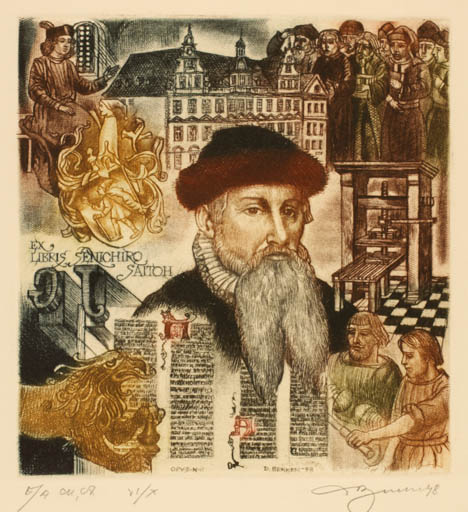

In addition to ex libris from the artists listed above, you can find works in the collection by Ivan Rusachek, Roman Sustov, and Yuri Yakovenko from Belarus Robert Baramov, Julian Jordanov, Jeni Katelieva, Pencho Koulekov, Jan Krejci, Petr Lazarov, Hristo Naidenov, and Nikolai Yanakiev from Bulgaria Gena Alexandrov, Alena Antonova, Karel Benes, Borivoj Borovsky, Frantisek Burant, Nadezda Cancikova, Vojtech Cinybulk, Jaroslav Dajc, Antonin Dolezal, Milan Entler, Michael Florian, Jan Hisek, Pavel Hlavaty, Ludmila Jandova, Ludmila Jirincova, Vlastimir Kacirek, Bohuslav Knobloch, Emil Kotrba, Karel Musil, Karel Oberthor, Zuzana Oberthorova, Antonin Odenhal, Raimund Ondracek, Ladislav Rusek, Vladimir Suchanek, Emilie Tomanova, and Josef Weiser from the Czech Republic Antal Fery, Hermina Horvath and Andrea Vertel from Hungary Natalija Cernetsova and Alexey Yupatov from Latvia Andrzej Buchaniec, Henryk Grajek and Jan Szmatloch from Poland Budimir Dimitrijevic from Serbia Petr Augustovic, Viktor Chrenko, Marcos Komachek, Karol Ondreicka and Katarina Smetanova from Slovakia Konstantin Kalynovych, Petro Prokopiv, and Vladimir Strutinskij from Ukraine, and Evgeny Blumkin, Anatoli Kalashnikov, Nina Kazimova, Yuri Ljukshin, Denis Reutow, Leonid Stroganov, Oleg Yakhnin, and Vladimir Zuev from Russia. The Christmas imagery ranges from conventional portraits of the Madonna and Child to more whimsical interpretations like Czech Artist Jiri Bouda's color lithograph of the Three Wise Men traveling by boat across what must surely be Lake Como in Italy and an etching by his compatriot, Jan Konupek, depicting the Magi as three wayfarers bringing a carp and vanocka bread loaf to a farm house "manger" for a traditional holiday feast! Many of the small format prints were made for Christmas cards and include the calendar year and the letters PF, an abbreviation of the French phrase, pour feliciter (to congratulate), used as a shorthand holiday greeting in parts of Eastern Europe.


And what do you make of Slovak Artist Leo Bednarik's strange vision, Untitled, where the figure of Christ seems to explode out of the dome of St. Czech Artist Jindrich Pilecek and Lithuanian Marius Liugaila have humorous takes on the Tower of Babel theme. Czech Printmaker Jan Kavan shows the Crucified Christ sprouting branches like a Tree of Life.

Consider Czech Artist Juri Salamoun's sardonic Golgotha and Golgotha II or Bulgarian Peter Velikov's surrealistic presentation of the Crucifixion as an event of cosmic proportions. You can also find ex libris on biblical narratives rendered in less conventional ways. Younger graphic artists, like Ukrainians David Bekker and Sergey Kirnitskiy, also produce small format prints on religious themes, evoking the works of the Old Masters. Estonian Artist Evald Okas and Czech Printmaker Antonin Kamenik, who come from a generation of book plate makers active before the Communist era, are represented in the Sacred Art Pilgrim Collection by two studies of the Head of Christ in a fairly traditional style. Many plates are now produced as signed and numbered small format fine art prints, known as "free" ex libris, never to be glued on to book covers.Įrotica seems to be the subject of choice for contemporary ex libris makers, but to my great surprise sacred subjects occasionally turn up on book plates and miniature prints, coming out of the former Soviet Bloc countries. Ex libris are once again in demand, eagerly sought by specialized collectors. Down through the ages, ex libris makers came up with ever more artful and imaginative designs for their clients’ home libraries, inspiring a mania for collecting book plates, lasting from the final quarter of the 19th Century until the 1920s. The first known book plates or ex libris -a Latin phrase meaning “from the library of”-are woodcuts from the 15th Century, displaying the owner’s name and coat of arms. With the advent of the printing press and the mass circulation of books, worried bibliophiles turned to artists to make special name tags in multiple copies to paste in the front of their treasured possessions in print. The Egyptians used to label their valuable papyri with enamel tablets to keep them from going astray, and medieval owners of priceless vellum manuscripts made sure to mark them with their names and heraldic crests. Getting borrowed books back has been a problem since the beginning of the written word.


 0 kommentar(er)
0 kommentar(er)
